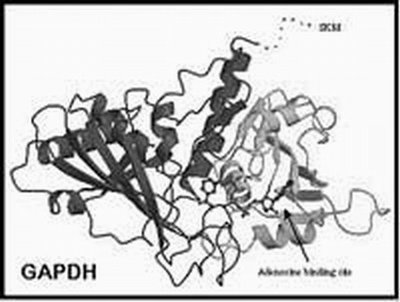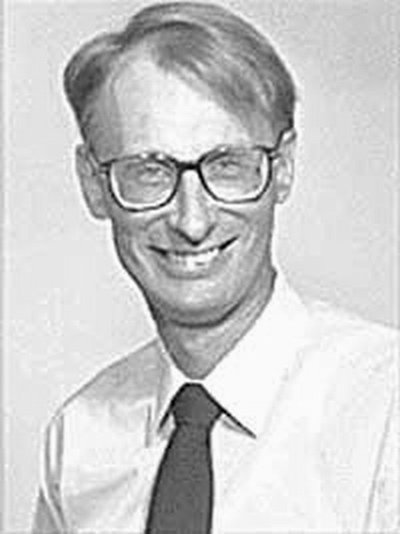November 29, 2001
UW research group awarded almost $19 million as part of NIH Protein Structure Initiative
By Pamela Wyngate
HS News & Community Relations
While the Human Genome Project and its controversy have gobbled up space in the science news, some local researchers have been awarded a cool $18.8 million to determine protein structures. The UW joins nine other national consortia in determining protein form and functions as part of the National Institutes of Health’s Protein Structure Initiative. Their funded project is called “Structural Genomics of Pathogenic Protozoa” (SGPP). One day this work may lead to the design of new therapeutics for many diseases.
Dr. Wim G.J. Hol, professor of biochemistry and biological structure, is the principal investigator on the four-year grant. Hol and his colleagues are interested in the protozoa, single-celled organisms, responsible for malaria, sleeping sickness, Chagas’ disease and leishmaniasis. These tropical diseases may sound like something out of a Hemingway novel, but the numbers of people currently infected are significant.
“Malaria kills about 2 million people every year,” says Hol. “The other diseases have fewer fatalities, but the diseases are tremendously harmful. There are hundreds of thousands of people dying from sleeping sickness and another hundred thousand dying from leishmaniasis each year.”
Yet few researchers study these illnesses. One reason is that the diseases are a problem in some of the poorest parts of the world, such as sub-Saharan Africa and the jungle regions of South America. This means there is little incentive for private companies to make pharmaceutical drugs because the financial return on those drugs would be limited. Compounding the problem are the facts that the few drugs that do exist are highly toxic and the organisms that cause the illnesses are becoming more and more drug-resistant. Yet the very flexibility of the organisms, which vexes pharmaceutical researchers, intrigues the biochemists.
“From a purely scientific view, these are fascinating organisms,” says Hol. “They outwit the human defense systems in absolutely fantastic ways. So there are going to be unusual protein molecules, which we’d like to solve the protein structure of and understand better.”
A protein is a long, slender spaghetti-like molecule, which folds up into a very well-defined, compact structure. For many years scientists have known that a protein is not just a sequence of amino acids. Proteins adopt a structure and that structure causes the protein to function. Within the protein structure are key areas, called active sites, where the action is on the protein. Clever biochemistry at the active site causes the protein to perform a function of one type or another.
“You really need to know the three-dimensional structure to understand how a protein works,” explains Hol. “Relatively small modifications in the same basic kind of scaffold can give proteins extremely dissimilar functions. Of course they often do similar things with very dissimilar folds. Nature is always full of surprises.”
Many protein structures are known, but there are many more that are unknown. Protein crystallographers, like Hol, describe the shapes of proteins. When combined with existing protein science, the information from the description of one protein structure can help other researchers predict the shapes of other proteins, mainly by analogy and homology.
Once a protein structure is described, further research can help drug manufacturers target these active sites to alter a protein’s function. Aspirin, for example, targets and sits exactly in the active site of a human protein.
Hol describes the UW contribution to the Protein Structure Initiative as a crossroads between the basic science of protein folding and therapeutic drug research.
“Our project will provide information about these unusually important and neglected global diseases, while also giving us a better understanding of the fundamental protein folding problem,” he explains. “The structures we describe will be immediately available for anyone in the world. Any organic chemist or computer expert will be able to start thinking about molecules to fit in active sites. That’s the beginning of drug design.”
In the next few months more than 35 people at the UW and its affiliates on the grant will begin the work to express thousands of parasite proteins and characterize a proposed 150 protein structures from the protozoa targeted.
The first step is to identify the novel structures in proteins. During the initial target selection phase, researchers use computational and experimental input to discern whether or not there is a similar structure already out there. If a new fold is likely, the protein will receive a high priority to be studied. Medical relevance of the protein will also be carefully considered in assigning priority.
In the second phase of the process, researchers wear two hats: protein farmers and, later, crystal creators. To grow the proteins, they inject genes into yeast or bacteria-usually Escherichia coli. When all goes well, the bacterium replicates, simultaneously creating lots of the foreign protein. The researchers then purify the protein out of the E. coli (or yeast).
The next step is creating crystals from the purified protein. Researchers add certain ingredients to supersaturate the solution so that just the protein precipitates out in crystals.
“Inside the crystals the proteins are arranged in a very regular way,” says Hol. “The regularity is almost miraculous, but we do it all the time. We may have to set up five or 50,000 trials before we have one. So we can’t say, ‘We’re going to crystallize your beloved protein tomorrow.’ That’s not how it works. Because we need to do so many trials, automation in the form of robotics is crucial for this Structural Genomics Project.”
The crystals themselves may be only .1 millimeter in the longest direction. (The tip of a single strand of human hair is approximately .1 mm in diameter.) Yet in this tiny crystal are tens of millions of copies of the same protein. In the UW project, scientists at the University of California, Berkeley, and Stanford University will beam high intensity X-rays, which are also very regular, through the many crystals to create an electron density map. This diffraction pattern, which looks like a series of random black dots, can be read using math and tenets of physics to identify the structure of the protein.
“Crystallography is very powerful in the sense that it can be incredibly accurate,” explains Hol. “It can determine certain structures at the picometer level, that is, in a thousand times more detail than a nanometer or a millionth of a millionth of a meter.”
This is important because even the position of key water molecules in a protein can be critical. “Crystallography is exceptionally well suited to discover such, and other, small molecules cleverly recruited by proteins to perform their sophisticated tasks,” he says.
Why would scientists worry about a couple of water molecules? Sometimes protein active sites may have three or four water molecules. Hark back to basic chemistry class and remember the very specific and powerful properties of H2O. Suffice to say, the presence of water molecules matters.
“It gets pretty exciting when the project is up to speed in a few years,” says Hol. “Hopefully we’ll make both the protein-fold researchers and the drug designers happy. The protein structure database will be dramatically enriched by our new structures. This should assist in understanding the ‘protein folding code.’ Somebody will take this research and make therapeutic drugs one day. The diseases we study are becoming such a well-known threat that governments and philanthropists are starting to get involved. I’m very optimistic.”
UW’s SGPP participants:
David Baker, associate professor of biochemistry
Fred Buckner, assistant professor of medicine
Erkang Fan, research assistant professor of biological structure
Stan Fields, professor of genetics and medicine and acting chair of the Department of Genome Sciences
Ethan Merritt, research associate professor of biochemstry and biological structure
Wes Van Voorhis, associate professor of medicine
Christophe Verlinde, associate professor of biochemstry and biological structure
Michael Gelb, associate professor of chemistry


